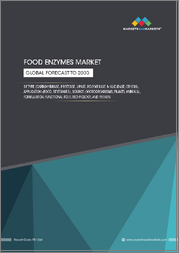
|
시장보고서
상품코드
1627719
세계의 프로테아제 시장 : 예측(2025-2030년)Protease Market - Forecasts from 2025 to 2030 |
||||||
프로테아제 시장은 5.91%의 연평균 복합 성장률(CAGR)로 성장하여 2025년 27억 4,900만 달러에서 2030년에는 36억 6,300만 달러에 이를 것으로 예상됩니다.
프로테아제는 무역, 특히 식품, 세제 및 의약품 응용 분야에서 사용되는 효소의 큰 분류를 형성합니다. 여기에는 아미다아제, 펩티다아제, 프로테아제가 포함됩니다. 중요한 산업용 효소 중 프로테아제는 단백질의 펩타이드 결합을 분해하는 화학적 및 생물학적 공정에서 매우 광범위하게 응용되고 있습니다. 프로테아제의 흥미로운 특징 중 하나는 천연물 생성에 있어서의 효율성이며, 보다 온화한 반응 조건에서 입체 특이성, 특이성, 생분해성 등의 특성을 나타냅니다. 수율을 향상시키기 위해 기업들은 혁신적인 반응 시간 단축 기술을 개발했습니다. 많은 소비재(FMCG)에 프로테아제가 포함되어 있어 그 관련성이 더욱 높아지고 있습니다. 프로테아제 시장 규모를 확대하는 가장 중요한 측면은 프로테아제가 다양한 분야에서 많은 용도를 가지고 있다는 것입니다. 독성과 병원성으로 인해 환경 친화적 인 원료로 시장을 확대하고 있습니다.
프로테아제 시장 성장 촉진요인
- 생명공학 및 연구 이니셔티브 증가는 프로테아제 시장 확대에 기여할 것임
프로테아제는 단백질 분석, DNA 연구, 재조합 DNA(rDNA) 기술을 위한 대중적인 도구로서의 잠재력으로 인해 생명공학 및 연구 프로젝트에 의해 시장이 지속적으로 활성화될 가능성이 높습니다. 프로테아제는 단백질의 정확한 절단을 가능하게 함으로써 단백질의 구조와 기능에 대한 연구를 촉진합니다. 따라서 프로테아제는 바이오 의약품의 생산, 정제 및 신약 개발 프로세스에 중요합니다. 또한 진단 절차 및 효소 보충 요법에도 활용되고 있습니다. 유전공학과 생명공학의 급속한 발전은 특정 역할을 가진 새로운 특수 프로테아제의 필요성을 제기하고 있습니다.
프로테아제 시장의 지리적 전망:
- 북미는 예측 기간 동안 비약적인 성장을 이룰 것입니다.
북미에서 프로테아제는 생명공학 및 의약품의 복잡하고 정교한 분야에서 치료제, 단백질 공학 및 의약품 개발에 적용되고 있습니다. 미국 FDA는 프로테아제 기반 제품 및 식품 및 의약품 산업의 개발 및 상용화를 지원하는 규제 환경을 제공하고 있으며, 규제는 프로테아제의 효능과 안전성을 보장함으로써 프로테아제 시장 출시를 돕고 있습니다. 기능성 식품 및 건강 보조 식품에 대한 수요가 증가함에 따라 이러한 제품에서 프로테아제 효소의 사용률이 높아지고 있습니다. 따라서 프로테아제의 건강상의 이점을 이해하는 사람들이 늘어남에 따라 건강 보조 식품에 대한 수요가 증가하고 있습니다.
이 보고서를 구매해야 하는 이유
- 통찰력 있는 분석 : 고객 부문, 정부 정책 및 사회경제적 요인, 소비자 선호도, 산업별, 기타 하위 부문에 중점을 두고 주요 지역뿐만 아니라 신흥 지역까지 포괄하는 상세한 시장 인사이트을 얻을 수 있습니다.
- 경쟁 환경: 세계 주요 기업들이 채택하고 있는 전략적 전략을 이해하고, 적절한 전략을 통한 시장 침투 가능성을 파악할 수 있습니다.
- 시장 성장 촉진요인과 미래 동향 : 역동적인 요인과 매우 중요한 시장 동향, 그리고 이들이 향후 시장 발전을 어떻게 형성할 것인지에 대해 알아봅니다.
- 행동 가능한 제안: 역동적인 환경 속에서 새로운 비즈니스 스트림과 수익을 발굴하기 위한 전략적 의사결정에 통찰력을 활용합니다.
- 다양한 사용자에 대응: 스타트업, 연구기관, 컨설턴트, 중소기업, 대기업에 유익하고 비용 효율적임.
어떤 용도로 사용되나요?
산업 및 시장 검토, 사업 기회 평가, 제품 수요 예측, 시장 진출 전략, 지리적 확장, 설비 투자 결정, 규제 프레임워크 및 영향, 신제품 개발, 경쟁의 영향
분석 범위
- 과거 데이터 및 예측(2022-2030년)
- 성장 기회, 과제, 공급망 전망, 규제 프레임워크, 고객 행동 및 트렌드 분석
- 경쟁사 포지셔닝, 전략 및 시장 점유율 분석
- 수익 성장률 및 예측 분석 : 부문별, 지역별(국가별)
- 기업 프로파일링(전략, 제품, 재무정보, 주요 동향 등)
목차
제1장 서론
- 시장 개요
- 시장의 정의
- 분석 범위
- 시장 세분화
- 통화
- 전제조건
- 기준연도 및 예측연도 타임라인
- 이해관계자에 있어서의 주요 이점
제2장 분석 방법
- 분석 디자인
- 분석 프로세스
제3장 주요 요약
- 주요 조사 결과
- CXO 관점
제4장 시장 역학
- 시장 성장 촉진요인
- 시장 성장 억제요인
- Porter의 Five Forces 분석
- 업계 밸류체인 분석
- 애널리스트의 견해
제5장 프로테아제 시장 : 원료별
- 서론
- 식물
- 동물
- 미생물
제6장 프로테아제 시장 : 형태별
- 서론
- 분말
- 액체
- 기타
제7장 프로테아제 시장 : 용도별
- 서론
- 동물사료 산업
- 식품 및 음료 산업
- 기타
제8장 프로테아제 시장 : 지역별
- 서론
- 북미
- 원료별
- 형태별
- 용도별
- 국가별
- 남미
- 원료별
- 형태별
- 용도별
- 국가별
- 유럽
- 원료별
- 형태별
- 용도별
- 국가별
- 중동 및 아프리카
- 원료별
- 형태별
- 용도별
- 국가별
- 아시아태평양
- 원료별
- 형태별
- 용도별
- 국가별
제9장 경쟁 환경과 분석
- 주요 기업과 전략 분석
- 시장 점유율 분석
- 기업인수합병(M&A), 합의, 사업 협력
- 경쟁 대시보드
제10장 기업 개요
- E.I. Du Pont De Nemours and Company
- Novozymes A/S
- Advanced Enzyme Technologies
- DSM
- Associated British Food
- Neova Technologies Inc
- Thermo Fisher Scientific
- Kemin Industries
- Promega Corporation
- Merck
- Novus International Inc.
- International Flavors & Fragrances Inc.
- Biocatalyst Ltd.
- Novonesis Group.
- Bioseutica BV.
The protease market is expected to grow at a CAGR of 5.91%, reaching a market size of US$3.663 billion in 2030 from US$2.749 billion in 2025.
Proteases form a large class of enzymes used in trade, especially in food, detergent, and pharmaceutical applications. They include amidases, peptidases, and proteinases. Among important industrial enzymes, proteases have a very wide range of applications in chemical and biological processes responsible for the breakdown of peptide ties in proteins. One of the interesting features of proteases is their efficiency in generating natural products, doing so in milder reaction conditions and exhibiting stereospecificity, specificity, and biodegradability among their properties. Innovative reaction-time-reduction techniques have been invented by firms for increased yield enhancement. Many fast-moving consumer goods (FMCG) include proteases, adding to their relevance. The most significant aspect of increasing the market size for proteases is that they have many applications in different sectors. The toxicity and pathogenicity make them even greener ingredients, expanding the market.
Protease Market Drivers
- Increasing biotechnology and research initiatives are contributing to the protease market expansion
Owing to their potentiality as popular tools for protein analysis, DNA research, and recombinant DNA (rDNA) technology, the market will likely be continually fueled by biotechnology and research projects. Proteases facilitate the study of protein structure and function by allowing for precise protein cleavage. They are thus important to biopharmaceuticals' production, purification, and drug discovery processes. They can also be found in diagnostic procedures and enzyme replacement therapies. The fast advancements in genetic engineering and biotechnology will also challenge the need for novel specialty proteases with specific roles.
Geographical Outlook of the Protease Market:
- North America is witnessing exponential growth during the forecast period.
In North America, proteases are used within the complex and sophisticated sectors of biotechnology and pharmaceuticals for application in therapeutics, protein engineering, and drug development. The US FDA provides a regulatory environment that helps develop and commercialize protease-based products and the food and pharmaceutical industries; regulation assists in the market adoption of proteases by ensuring they are effective and safe. Increasing demand for functional foods and health supplements has resulted in the high usage of the protease enzyme in such products. Therefore, an increasing demand for nutraceuticals is aroused as more people understand proteases' health benefits.
Reasons for buying this report:-
- Insightful Analysis: Gain detailed market insights covering major as well as emerging geographical regions, focusing on customer segments, government policies and socio-economic factors, consumer preferences, industry verticals, other sub- segments.
- Competitive Landscape: Understand the strategic maneuvers employed by key players globally to understand possible market penetration with the correct strategy.
- Market Drivers & Future Trends: Explore the dynamic factors and pivotal market trends and how they will shape up future market developments.
- Actionable Recommendations: Utilize the insights to exercise strategic decision to uncover new business streams and revenues in a dynamic environment.
- Caters to a Wide Audience: Beneficial and cost-effective for startups, research institutions, consultants, SMEs, and large enterprises.
What do businesses use our reports for?
Industry and Market Insights, Opportunity Assessment, Product Demand Forecasting, Market Entry Strategy, Geographical Expansion, Capital Investment Decisions, Regulatory Framework & Implications, New Product Development, Competitive Intelligence
Report Coverage:
- Historical data & forecasts from 2022 to 2030
- Growth Opportunities, Challenges, Supply Chain Outlook, Regulatory Framework, Customer Behaviour, and Trend Analysis
- Competitive Positioning, Strategies, and Market Share Analysis
- Revenue Growth and Forecast Assessment of segments and regions including countries
- Company Profiling (Strategies, Products, Financial Information, and Key Developments among others)
The protease market is segmented and analyzed as follows:
By Source
- Plants
- Animals
- Microbes
By Form
- Powder
- Liquid
- Others
By Application
- Animal feed industry
- Food & Beverage industry
- Others
By Geography
- North America
- USA
- Canada
- Mexico
- South America
- Brazil
- Argentina
- Others
- Europe
- United Kingdom
- Germany
- Italy
- Spain
- Others
- Middle East and Africa
- Saudi Arabia
- Israel
- Others
- Asia Pacific
- Japan
- China
- India
- Australia
- South Korea
- Taiwan
- Thailand
- Indonesia
- Others
TABLE OF CONTENTS
1. INTRODUCTION
- 1.1. Market Overview
- 1.2. Market Definition
- 1.3. Scope of the Study
- 1.4. Market Segmentation
- 1.5. Currency
- 1.6. Assumptions
- 1.7. Base and Forecast Years Timeline
- 1.8. Key Benefits to the Stakeholder
2. RESEARCH METHODOLOGY
- 2.1. Research Design
- 2.2. Research Processes
3. EXECUTIVE SUMMARY
- 3.1. Key Findings
- 3.2. CXO Perspective
4. MARKET DYNAMICS
- 4.1. Market Drivers
- 4.2. Market Restraints
- 4.3. Porter's Five Forces Analysis
- 4.3.1. Bargaining Power of Suppliers
- 4.3.2. Bargaining Power of Buyers
- 4.3.3. Threat of New Entrants
- 4.3.4. Threat of Substitutes
- 4.3.5. Competitive Rivalry in the Industry
- 4.4. Industry Value Chain Analysis
- 4.5. Analyst View
5. PROTEASE MARKET BY SOURCE
- 5.1. Introduction
- 5.2. Plants
- 5.3. Animals
- 5.4. Microbes
6. PROTEASE MARKET BY FORM
- 6.1. Introduction
- 6.2. Powder
- 6.3. Liquid
- 6.4. Others
7. PROTEASE MARKET BY APPLICATION
- 7.1. Introduction
- 7.2. Animal feed industry
- 7.3. Food & Beverage industry
- 7.4. Others
8. PROTEASE MARKET BY GEOGRAPHY
- 8.1. Introduction
- 8.2. North America
- 8.2.1. By Source
- 8.2.2. By Form
- 8.2.3. By Application
- 8.2.4. By Country
- 8.2.4.1. USA
- 8.2.4.2. Canada
- 8.2.4.3. Mexico
- 8.3. South America
- 8.3.1. By Source
- 8.3.2. By Form
- 8.3.3. By Application
- 8.3.4. By Country
- 8.3.4.1. Brazil
- 8.3.4.2. Argentina
- 8.3.4.3. Others
- 8.4. Europe
- 8.4.1. By Source
- 8.4.2. By Form
- 8.4.3. By Application
- 8.4.4. By Country
- 8.4.4.1. United Kingdom
- 8.4.4.2. Germany
- 8.4.4.3. Italy
- 8.4.4.4. Spain
- 8.4.4.5. Others
- 8.5. Middle East and Africa
- 8.5.1. By Source
- 8.5.2. By Form
- 8.5.3. By Application
- 8.5.4. By Country
- 8.5.4.1. Saudi Arabia
- 8.5.4.2. Israel
- 8.5.4.3. Others
- 8.6. Asia Pacific
- 8.6.1. By Source
- 8.6.2. By Form
- 8.6.3. By Application
- 8.6.4. By Country
- 8.6.4.1. Japan
- 8.6.4.2. China
- 8.6.4.3. India
- 8.6.4.4. Australia
- 8.6.4.5. South Korea
- 8.6.4.6. Taiwan
- 8.6.4.7. Thailand
- 8.6.4.8. Indonesia
- 8.6.4.9. Others
9. COMPETITIVE ENVIRONMENT AND ANALYSIS
- 9.1. Major Players and Strategy Analysis
- 9.2. Market Share Analysis
- 9.3. Mergers, Acquisitions, Agreements, and Collaborations
- 9.4. Competitive Dashboard
10. COMPANY PROFILES
- 10.1. E.I. Du Pont De Nemours and Company
- 10.2. Novozymes A/S
- 10.3. Advanced Enzyme Technologies
- 10.4. DSM
- 10.5. Associated British Food
- 10.6. Neova Technologies Inc
- 10.7. Thermo Fisher Scientific
- 10.8. Kemin Industries
- 10.9. Promega Corporation
- 10.10. Merck
- 10.11. Novus International Inc.
- 10.12. International Flavors & Fragrances Inc.
- 10.13. Biocatalyst Ltd.
- 10.14. Novonesis Group.
- 10.15. Bioseutica BV.



















